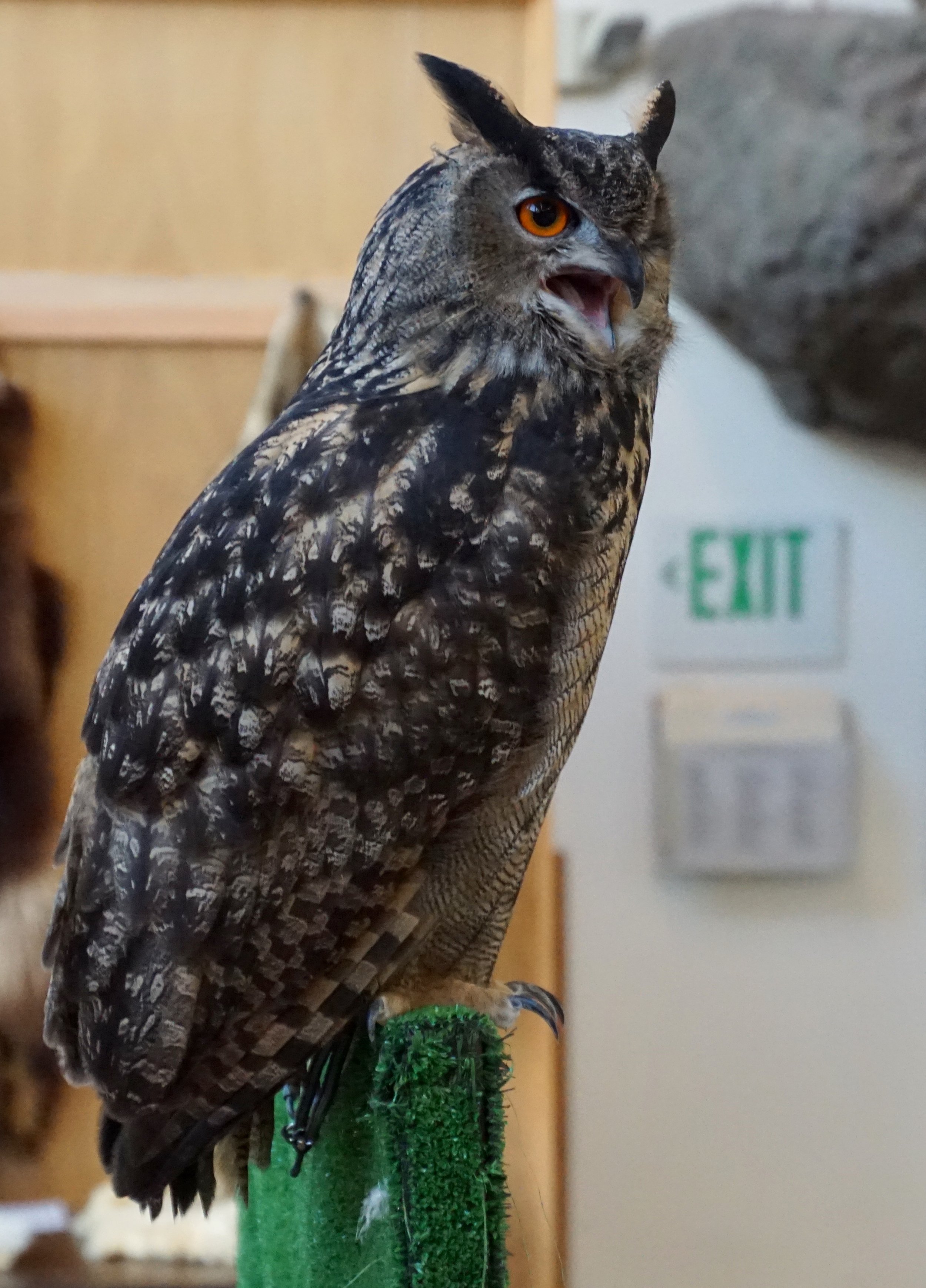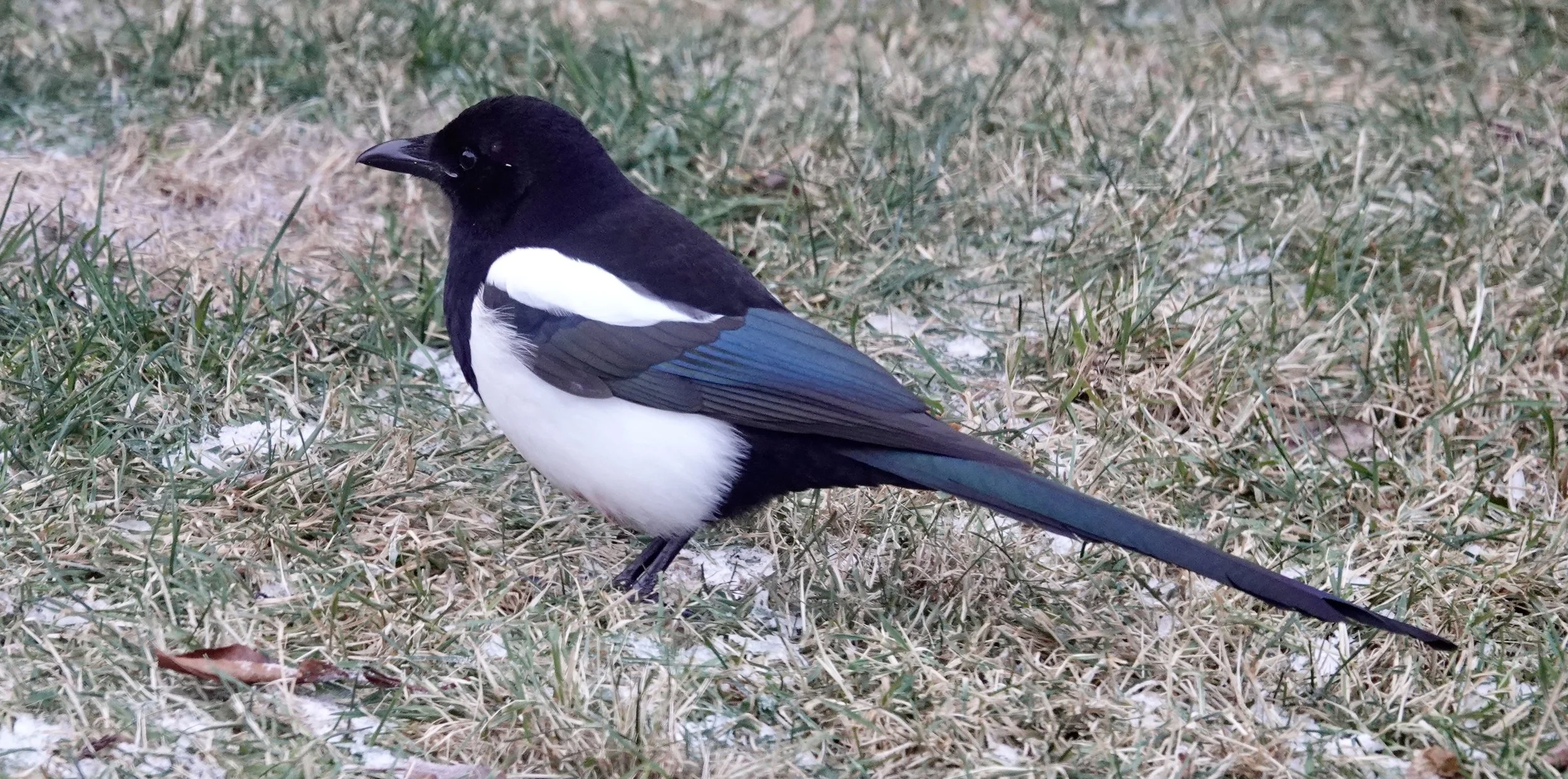Eurasian Eagle-owls are apex predators. This large owl is found at the American Bald Eagle Foundation in Haines, Alaska.
Eurasian Eagle-owl.
Not all Eurasian Eagle-owls enjoy being near an exit sign.
Naturally
A couple of dandelions still bloomed in the yard. They do so to establish possibility. The red berries on yard trees offered a glimpse of another year. Fallen leaves amplified
the sounds of things that were and weren’t there.
The cloudiest months are November and December, with an average of 18 cloudy days each in Minnesota. November averages five days with clear skies and December six. But one day in November, the sky was so blue, gulls were swimming in it. Overall, Minnesota is warmer and wetter than in 1900. Ask anybody who was around in 1900, they’ll tell you. November has been blustery. The windiest month on average for most of Minnesota is April. Minneapolis is windier than the Windy City (Chicago), as are Milwaukee, Boston and a host of other cities.
Penn State University researchers and wildlife officials in Iowa found that over 80% of deer in their samples tested positive for the COVID-19 virus, with samples taken from April 2020 through January 2021 showing it’s spreading. There’s no evidence to suggest deer-to-human transmission. According to the study, the COVID-19 transmissions among deer in Iowa likely resulted from multiple human-to-deer spillover events and deer-to-deer transmission. Rachel Ruden, Iowa’s state wildlife veterinarian and an author of the study, said there are many opportunities for transmission given the 445,000 deer in the state, and the virus could be spread by people feeding deer, through sewage discharges or in an odd way like a deer licking a gob of used chewing tobacco spit out by an infected hunter. Ruden said, “All of this is a striking example that we’re all in this pandemic together.”
Nature by the book
I read a delightful book by Rosemary Mosco titled, “A Pocket Guide to Pigeon Watching,” subtitled, “Getting to Know the World’s Most Misunderstood Bird.” She dedicated the book to her father, who grew up in a Manhattan tenement, and knew only three kinds of birds: the gray ones (pigeons), the little brown ones (house sparrows) and seagulls. The book covers about everything you could cover a pigeon with. A pigeon can find its way home from unfamiliar locations. How? Scientists believe the birds use landmarks, smells, the position of the sun, earth’s magnetic field, and the female pigeon stops to ask for directions. I tossed that last one in there. Don’t blame a scientist for it.
In WWI, the Lost Battalion (US soldiers) was behind enemy lines in the Argonne Forest when they fell under friendly artillery fire. They released a messenger pigeon named Cher Ami, which is French for “dear friend.” Despite being shot, Cher Ani delivered the message to headquarters and saved many lives. Cher Ami received the Croix de Guerre, one of France’s highest military honors.
The author included a quote from Charles Darwin, “I will show you my pigeons! Which is the greatest treat, in my opinion, which can be offered to human beings.”
As I’d say when I was a ragamuffin, I had a fun time reading this book.
Q&A
Dale Waltz of Rochester asked about gray squirrels with white ears. They often have white hair behind their ears and on the chin, throat and belly. Gray squirrels may have white or brownish bellies and, in winter, white ear tufts. Black and white squirrels are variations of the gray squirrel. The black squirrels will not have white-tipped fur or white bellies. Eastern grey squirrels often have a lot of red in their fur. Underparts and eye-rings are buffy brown to white, usually lighter in winter. The backs of the ears, tan to cinnamon in color, have white tips in the winter
“If I feed just one thing to the wild birds in my Minnesota backyard, what should it be?” I’d recommend black-oil sunflower seeds. They have the greatest appeal to the broadest variety of winter birds we want to see and offer high energy content. This take-it-or-leave-it bird table saves you the time, effort and cost of having to post a daily menu.
“Why are birds banded?” According to the USGS Bird Banding Laboratory, bird banding data are useful in both scientific research and management and conservation projects. Individual identification of birds makes it possible to study dispersal and migration, behavior and social structure, lifespan and survival rate, reproductive success and population growth.
“Do birds have a sense of smell?” Researchers at the Max Planck Institute for Ornithology and the Cawthron Institute in New Zealand provided genetic evidence that many bird species have a well-developed sense of smell, but the ability varies among bird groups. Vultures, seabirds, kiwis and parrots have well-developed olfactory glands.
Thanks for stopping by
“We are a landscape of all we have seen.”—Isamu Noguchi.
“There is nothing so useless as doing efficiently that which should not be done at all.”—Peter Drucker.
Do good.
©️Al Batt 2021
At this time of the year, a European Starling looks as if it’s covered in tiny footprints. Its bill has darkened along with the plumage change. Photo by Al Batt
A lovely place to visit in Haines, Alaska.
Haines, Alaska, in November.
The man in the moon was smiling.
The weather forecast in Haines, Alaska, was for snow and magpies.
The weather had been cold and birdy.
It’s not Soap Suds Al. It’s me—or is it? Haines, Alaska.
Both teams were cold to begin the game. Fortunately, it was played indoors.













